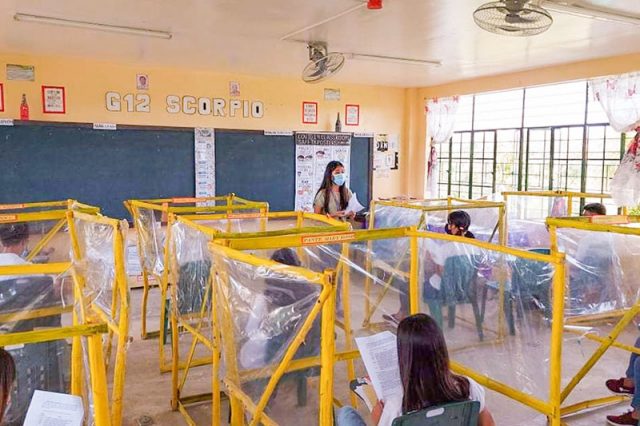
Concerned adult Filipinos made suggestions on how to improve the classroom setup and ensure the safety of students amid the resumption of face-to-face classes.
The pilot implementation of the limited traditional learning setup kicked off this Monday.
The Facebook page of the Department of Education shared photos showing how the Mary Perpetua E. Brioso National High School in Brgy. Tigbao at Milagros, Masbate is conducting its physical classes after more than a year of distance learning.
The photo showed classrooms of Grade 11 and 12 students of Mary Perpeta E. Brioso National High School.
“Ang mga paaralang kabilang sa implementasyong ito ay nagpapatupad ng mahigpit na safety protocols sa loob ng silid-aralan,” the agency said on Facebook.
“Kinakailangan ding dumaan ng mga guro, mag-aaral, at iba pang opisyal sa washing area, temperature checking, at triage area upang masiguro ang kaligtasan ng lahat sa paaralan,” it added.
Apart from wearing of masks, huge plastic barriers were also installed around each student’s arm chair as part of the school’s COVID-19 safety protocols.
Some online users did not like the new classroom setting and expressed concern over the plastic barriers installed. They said that the enclosure is not good for students who are already struggling with the policy to wear face masks.
Others also thought that teachers should wear microphones to be heard better by students at the back since their voices would be muffled by the personal protective covering.
“I think face mask and [physical] distancing are enough inside the classroom. No need for those barriers, nakaka-suffocate ‘yan,” a Facebook user suggested in the comments.
“Maglagay ng sanitizer sa door entrance. Dapat may mic ang mga teacher para kahit ‘yung mga nasa likod e madinig siya, so no need lumapit sa kanila,” she added.
“Ang init at ang hassle ng ganyan. [Puwede] nman na [siguro] ang walang harang, basta 1 meter apart lang. Tsaka na mask naman. Parang dito lang sa Pilipinas ang ganyan. Sa ibang bansa wala namang harang sa classroom, opinyon lang,” another Facebook user wrote.
Some argued that the plastic coverings would only hinder the students’ eyesight. They cited the plastic are not not too clear to view the notes on the board across them.
“Ang hirap niyan, paano ‘pag malabo ‘yung plastic cover? Paano pa makikita ng estudyante ‘yang guro na nag-di-discuss sa harap? Kinig kinig nalang, ganun?” an online user commented.
They then urged the schools to focus on improving the ventilation system in classrooms.
“I wish maayos [ang] ventilation sa mga rooms… napakainit niyan kung nababalot ka sa plastic cover,” another Filipino wrote.
“Ang init naman po yata… Naka-cubicle with mask pa. Kulang sa ventilation… baka lalo pang magkaubo kasi possible matuyuan ng pawis,” a different user likewise commented.
What experts said
Similar sentiments were also raised last month when a public school in Manila shared pictures of how it was preparing for onsite classes. Each student’s desk was also enclosed in acrylic barriers.
The setup previously concerned some Filipinos who reminded officials that the virus causing COVID-19 is airborne and that ventilation should be the key in mitigating its transmission.
A report by New York Times last August argued that plastic barriers “do little to stop the spread of the coronavirus.”
It said that under normal conditions, exhaled breath particles in classrooms, stores and offices disperse, get carried by air currents and then get replaced by fresh air around every 15 to 20 minutes, depending on the ventilation system.
The report said that installing plastic barriers can change the air flow in a room, disrupt normal ventilation and create “dead zones” where viral aerosol particles can build up and become highly concentrated.
“If you have a forest of barriers in a classroom, it’s going to interfere with proper ventilation of that room,” Linsey Marr, professor of civil and environmental engineering at Virginia Tech, was quoted as saying before.
“Everybody’s aerosols are going to be trapped and stuck there and building up, and they will end up spreading beyond your own desk,” she added.
RELATED: Isko Moreno told: Prioritize airflow over barriers in classrooms as classes start









